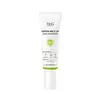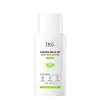What's inside
What's inside
 Key Ingredients
Key Ingredients

 Benefits
Benefits

 Concerns
Concerns

 Ingredients Side-by-side
Ingredients Side-by-side

Water
Skin ConditioningDibutyl Adipate
EmollientPropanediol
SolventAlcohol
AntimicrobialEthylhexyl Triazone
UV AbsorberTerephthalylidene Dicamphor Sulfonic Acid
UV AbsorberGlycerin
HumectantNiacinamide
SmoothingPolyglyceryl-3 Distearate
EmulsifyingTromethamine
Buffering1,2-Hexanediol
Skin ConditioningPentylene Glycol
Skin ConditioningDiethylamino Hydroxybenzoyl Hexyl Benzoate
UV FilterCetearyl Alcohol
EmollientCaprylyl Methicone
Skin ConditioningPolysilicone-15
UV FilterCaesalpinia Spinosa Fruit Extract
Skin ProtectingBuddleja Officinalis Flower Extract
UV FilterKappaphycus Alvarezii Extract
Skin ConditioningPinus Pinaster Bark Extract
AntioxidantSodium Hyaluronate
HumectantCaprylic/Capric/Succinic Triglyceride
EmollientPalmitic Acid
EmollientGlyceryl Stearate
EmollientBis-Ethylhexyloxyphenol Methoxyphenyl Triazine
Skin ConditioningPotassium Cetyl Phosphate
EmulsifyingPolymethylsilsesquioxane
Stearic Acid
CleansingMethylpropanediol
SolventAmmonium Acryloyldimethyltaurate/Vp Copolymer
Silica
AbrasivePolyacrylate Crosspolymer-6
Emulsion StabilisingGlyceryl Stearate Citrate
EmollientEthylhexylglycerin
Skin ConditioningAdenosine
Skin ConditioningSodium Polyacrylate
AbsorbentPolyether-1
Myristic Acid
CleansingT-Butyl Alcohol
PerfumingEctoin
Skin ConditioningHydrolyzed Sodium Hyaluronate
Skin ConditioningButylene Glycol
HumectantBiosaccharide Gum-1
Humectant7-Dehydrocholesterol
Emulsion StabilisingLactobacillus Ferment
Skin ConditioningTocopherol
AntioxidantHydrolyzed Collagen
EmollientHydroxypropyltrimonium Hyaluronate
Sodium Acetylated Hyaluronate
HumectantSodium Hyaluronate Crosspolymer
HumectantPotassium Hyaluronate
Skin ConditioningHydrolyzed Hyaluronic Acid
HumectantHyaluronic Acid
HumectantParfum
MaskingWater, Dibutyl Adipate, Propanediol, Alcohol, Ethylhexyl Triazone, Terephthalylidene Dicamphor Sulfonic Acid, Glycerin, Niacinamide, Polyglyceryl-3 Distearate, Tromethamine, 1,2-Hexanediol, Pentylene Glycol, Diethylamino Hydroxybenzoyl Hexyl Benzoate, Cetearyl Alcohol, Caprylyl Methicone, Polysilicone-15, Caesalpinia Spinosa Fruit Extract, Buddleja Officinalis Flower Extract, Kappaphycus Alvarezii Extract, Pinus Pinaster Bark Extract, Sodium Hyaluronate, Caprylic/Capric/Succinic Triglyceride, Palmitic Acid, Glyceryl Stearate, Bis-Ethylhexyloxyphenol Methoxyphenyl Triazine, Potassium Cetyl Phosphate, Polymethylsilsesquioxane, Stearic Acid, Methylpropanediol, Ammonium Acryloyldimethyltaurate/Vp Copolymer, Silica, Polyacrylate Crosspolymer-6, Glyceryl Stearate Citrate, Ethylhexylglycerin, Adenosine, Sodium Polyacrylate, Polyether-1, Myristic Acid, T-Butyl Alcohol, Ectoin, Hydrolyzed Sodium Hyaluronate, Butylene Glycol, Biosaccharide Gum-1, 7-Dehydrocholesterol, Lactobacillus Ferment, Tocopherol, Hydrolyzed Collagen, Hydroxypropyltrimonium Hyaluronate, Sodium Acetylated Hyaluronate, Sodium Hyaluronate Crosspolymer, Potassium Hyaluronate, Hydrolyzed Hyaluronic Acid, Hyaluronic Acid, Parfum
Water
Skin ConditioningZinc Oxide
Cosmetic ColorantCoco-Caprylate/Caprate
EmollientCaprylyl Methicone
Skin ConditioningPropylheptyl Caprylate
EmollientPropanediol
SolventButyloctyl Salicylate
Skin ConditioningCyclohexasiloxane
EmollientNiacinamide
SmoothingButylene Glycol Dicaprylate/Dicaprate
EmollientPolyglyceryl-3 Polydimethylsiloxyethyl Dimethicone
Skin ConditioningPolyglyceryl-2 Dipolyhydroxystearate
Skin ConditioningCentella Asiatica Extract
CleansingBacopa Monnieri Extract
Skin ConditioningDisiloxane
Skin ConditioningC13-15 Alkane
SolventDisteardimonium Hectorite
StabilisingPolymethylsilsesquioxane
Pinus Pinaster Bark Extract
AntioxidantCaesalpinia Spinosa Fruit Extract
Skin ProtectingKappaphycus Alvarezii Extract
Skin ConditioningBuddleja Officinalis Flower Extract
UV FilterLauryl Polyglyceryl-3 Polydimethylsiloxyethyl Dimethicone
Skin ConditioningPolyhydroxystearic Acid
EmulsifyingPolyglyceryl-3 Polyricinoleate
EmulsifyingMagnesium Sulfate
Triethoxycaprylylsilane
1,2-Hexanediol
Skin ConditioningTrihydroxystearin
Skin ConditioningSilica
AbrasiveNeopentyl Glycol Diethylhexanoate
EmollientGlyceryl Caprylate
EmollientCaprylyl Glycol
EmollientEthylhexylglycerin
Skin ConditioningAdenosine
Skin ConditioningTocopherol
AntioxidantWater, Zinc Oxide, Coco-Caprylate/Caprate, Caprylyl Methicone, Propylheptyl Caprylate, Propanediol, Butyloctyl Salicylate, Cyclohexasiloxane, Niacinamide, Butylene Glycol Dicaprylate/Dicaprate, Polyglyceryl-3 Polydimethylsiloxyethyl Dimethicone, Polyglyceryl-2 Dipolyhydroxystearate, Centella Asiatica Extract, Bacopa Monnieri Extract, Disiloxane, C13-15 Alkane, Disteardimonium Hectorite, Polymethylsilsesquioxane, Pinus Pinaster Bark Extract, Caesalpinia Spinosa Fruit Extract, Kappaphycus Alvarezii Extract, Buddleja Officinalis Flower Extract, Lauryl Polyglyceryl-3 Polydimethylsiloxyethyl Dimethicone, Polyhydroxystearic Acid, Polyglyceryl-3 Polyricinoleate, Magnesium Sulfate, Triethoxycaprylylsilane, 1,2-Hexanediol, Trihydroxystearin, Silica, Neopentyl Glycol Diethylhexanoate, Glyceryl Caprylate, Caprylyl Glycol, Ethylhexylglycerin, Adenosine, Tocopherol
Ingredients Explained
These ingredients are found in both products.
Ingredients higher up in an ingredient list are typically present in a larger amount.
1,2-Hexanediol is a synthetic liquid and another multi-functional powerhouse.
It is a:
- Humectant, drawing moisture into the skin
- Emollient, helping to soften skin
- Solvent, dispersing and stabilizing formulas
- Preservative booster, enhancing the antimicrobial activity of other preservatives
Adenosine is in every living organism. It is one of four components in nucleic acids that helps store our DNA.
Adenosine has many benefits when used. These benefits include hydrating the skin, smoothing skin, and reducing wrinkles. Once applied, adenosine increases collagen production. It also helps with improving firmness and tissue repair.
Studies have found adenosine may also help with wound healing.
In skincare products, Adenosine is usually derived from yeast.
Learn more about AdenosineThis ingredient is derived from a shrub native to central and southern China.
According to a manufacturer, this ingredient is rich in polyphenols that provide strong antioxidant protection against UV and blue light damage.
Fun fact: This flower is traditionally used in Chinese and Korean medicine.
Learn more about Buddleja Officinalis Flower ExtractWe don't have a description for Caesalpinia Spinosa Fruit Extract yet.
Caprylyl Methicone is a type of silicone.
It helps soften and soothe the skin by creating a thin film on top. This film helps trap moisture, keeping your skin hydrated.
Ethylhexylglycerin (we can't pronounce this either) is commonly used as a preservative and skin softener. It is derived from glyceryl.
You might see Ethylhexylglycerin often paired with other preservatives such as phenoxyethanol. Ethylhexylglycerin has been found to increase the effectiveness of these other preservatives.
We don't have a description for Kappaphycus Alvarezii Extract yet.
Niacinamide is a multitasking form of vitamin B3 that strengthens the skin barrier, reduces pores and dark spots, regulates oil, and improves signs of aging.
And the best part? It's gentle and well-tolerated by most skin types, including sensitive and reactive skin.
You might have heard of "niacin flush", or the reddening of skin that causes itchiness. Niacinamide has not been found to cause this.
In very rare cases, some individuals may not be able to tolerate niacinamide at all or experience an allergic reaction to it.
If you are experiencing flaking, irritation, and dryness with this ingredient, be sure to double check all your products as this ingredient can be found in all categories of skincare.
When incorporating niacinamide into your routine, look out for concentration amounts. Typically, 5% niacinamide provides benefits such as fading dark spots. However, if you have sensitive skin, it is better to begin with a smaller concentration.
When you apply niacinamide to your skin, your body converts it into nicotinamide adenine dinucleotide (NAD). NAD is an essential coenzyme that is already found in your cells as "fuel" and powers countless biological processes.
In your skin, NAD helps repair cell damage, produce new healthy cells, support collagen production, strengthen the skin barrier, and fight environmental stressors (like UV and pollution).
Our natural NAD levels start to decline with age, leading to slower skin repair, visible aging, and a weaker skin barrier. By providing your skin niacinamide, you're recharging your skin's NAD levels. This leads to stronger, healthier, and younger looking skin.
Another name for vitamin B3 is nicotinamide. This vitamin is water-soluble and our bodies don't store it. We obtain Vitamin B3 from either food or skincare. Meat, fish, wheat, yeast, and leafy greens contain vitamin B3.
The type of niacinamide used in skincare is synthetically created.
Learn more about NiacinamideThis ingredient is also known as Maritime pine. It has antioxidant properties.
Polymethylsilsesquioxane is a silicone used as a film forming agent.
When applied to the skin, this ingredient creates an invisible film on the surface. This film still allows oxygen to pass through, but prevents moisture from escaping. This can help condition and hydrate the skin. It also leaves a silky feel when applied.
Polymethylsilsesquioxane has not been shown to clog pores. It has been deemed safe to use up to 55%, but most cosmetics use much less.
If you have concerns about using this ingredient, we recommend speaking with a professional.
Learn more about PolymethylsilsesquioxanePropanediol is an all-star ingredient. It softens, hydrates, and smooths the skin.
It’s often used to:
Propanediol is not likely to cause sensitivity and considered safe to use. It is derived from corn or petroleum with a clear color and no scent.
Learn more about PropanediolSilica, also known as silicon dioxide, is a naturally occurring mineral. It is used as a fine, spherical, and porous powder in cosmetics.
Though it has exfoliant properties, the function of silica varies depending on the product.
The unique structure of silica enhances the spreadability and adds smoothness, making it a great texture enhancer.
It is also used as an active carrier, emulsifier, and mattifier due to its ability to absorb excess oil.
In some products, tiny microneedles called spicules are made from silica or hydrolyzed sponge. When you rub them in, they lightly polish away dead skin layers and enhance the penetration of active ingredients.
Learn more about SilicaTocopherol (also known as Vitamin E) is a common antioxidant used to help protect the skin from free-radicals and strengthen the skin barrier. It's also fat soluble - this means our skin is great at absorbing it.
Vitamin E also helps keep your natural skin lipids healthy. Your lipid skin barrier naturally consists of lipids, ceramides, and fatty acids. Vitamin E offers extra protection for your skin’s lipid barrier, keeping your skin healthy and nourished.
Another benefit is a bit of UV protection. Vitamin E helps reduce the damage caused by UVB rays. (It should not replace your sunscreen). Combining it with Vitamin C can decrease sunburned cells and hyperpigmentation after UV exposure.
You might have noticed Vitamin E + C often paired together. This is because it is great at stabilizing Vitamin C. Using the two together helps increase the effectiveness of both ingredients.
There are often claims that Vitamin E can reduce/prevent scarring, but these claims haven't been confirmed by scientific research.
Learn more about TocopherolWater. It's the most common cosmetic ingredient of all. You'll usually see it at the top of ingredient lists, meaning that it makes up the largest part of the product.
So why is it so popular? Water most often acts as a solvent - this means that it helps dissolve other ingredients into the formulation.
You'll also recognize water as that liquid we all need to stay alive. If you see this, drink a glass of water. Stay hydrated!
Learn more about Water